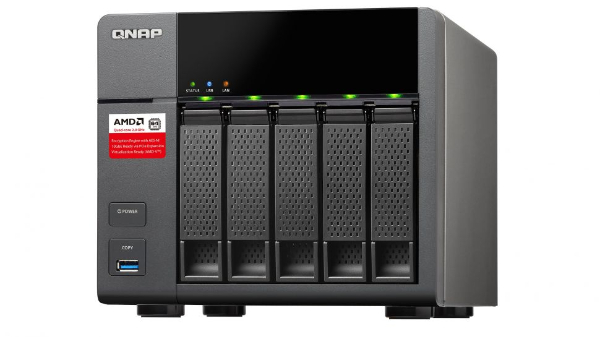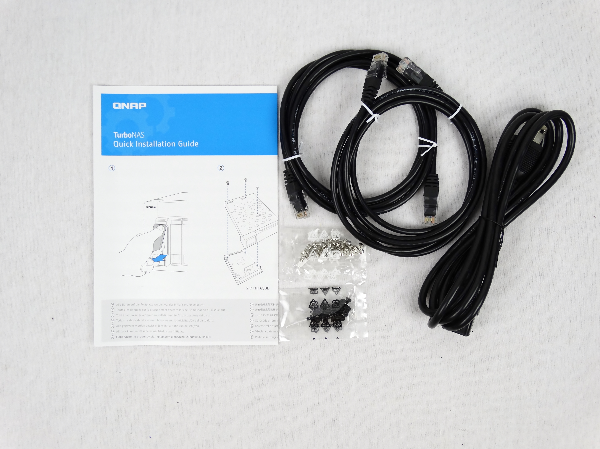Early Verdict
After looking at the other NAS products in this price range, the targeted small business features, future upgrade path and existing performance, QNAP's TS-563 is the clear market leader. You can spend more to get less from other products, you can spend a lot more to get more, but on a limited budget and a determination to get the most bang for your buck, this is the NAS I would buy for my office.
Pros
- +
Future upgrade path • Impressive performance • Superior software features • Timeless hardware design
Cons
- -
No internal mSATA SSD support for cache
Why you can trust Tom's Hardware
Specifications, Pricing, Warranty & Accessories
The QNAP models announced at least year's Computex are coming to market. The TS-563 uses AMD's low-power G-series system-on-chip (SoC) to bring award-winning features to this competitive market.
A while back, we tested the Synology DS415+ four-bay network attached storage (NAS) system and were critical of its limited features. After this review, when you see what QNAP is offering, you will understand why Synology had to endure our criticism. QNAP leads the SMB NAS market in features per dollar. Priced within a few bucks of the DS-415+, the QNAP TS-563 is a five-bay system with one-touch copy functionality, a powerful software suite and optional 10Gb Ethernet expansion. The hardware features complement QNAP's software, now up to QTS 4.2.
To achieve such an aggressive price point, QNAP employed AMD's new G-series SoC with hardware-accelerated encryption and video. Anytime I read the phrase performance per watt, I interpret it as poor performance at low power. AMD really likes to plug this marketing message into its press releases, so I didn't expect much from the G-series products. That changed when we tested the TVS-863+ and measured great performance on both 1GbE and 10GbE networks. The numbers weren't just great; they were even competitive with products using Intel's SoCs. We can't always say that about the other markets AMD serves.
MORE: All Storage ArticlesMORE: Latest Storage News
MORE: Storage in the Forums
The TS-563 ships in two versions with different amounts of system memory. The lower-price option ships with 2GB of DDR3 in a single SO-DIMM. The 8GB model we're testing today ships with two 4GB DDR3 SO-DIMMs populating both available slots. Either model can be updated with dual 8GB SO-DIMMs to a maximum of 16GB at 1600 MT/s. Why worry about RAM? Similar to your home PC, applications are loaded into system memory for faster access by the CPU. This system has an extensive list of software you can add, making more RAM an attractive attribute.
Powering those apps is AMD's GX-420MC SoC, sporting a 2GHz quad-core processor with 2MB of L2 cache and a 17.5W TDP. It's a Jaguar derivative, built on a 28nm process. AMD endows the SoC with AES-NI instruction support, accelerating encryption and decryption.
Data stored in the TS-563 is spread between as many as five internal drives, which can be a mix of mechanical and solid-state devices. SSD-based caching is supported, enabling high-performance application server functionality, if that's something you're interested in. But most folks will apply RAID 5 across the five bays, creating a more traditional array. RAID 6 and 10 are also possible, but RAID 5 is ideal for this type of system.
Get Tom's Hardware's best news and in-depth reviews, straight to your inbox.
There are also several connectivity options. Out of the box, you get two GbE ports. Hook up to one of them, both on a single network or two ports on two networks. You can also team them with link aggregation or upgrade the system using an available four-lane PCIe 2.0 slot. Expansion options include single- and dual-port 10GbE.
The system also has five USB 3.0 ports that open up more options. I love using the front USB 3.0 port to charge my cellphone and tablet. It's surrounded by a button that, when activated, saves data from whatever is plugged in. Four additional USB 3.0 ports on the back of the system can be used for storage expansion with one of QNAP's available enclosures. You can also use them to control a UPS, host an optical drive or charge other mobile devices.
Price, Warranty & Accessories
We found the TS-563 available for as low as $542.47 (for the 2GB model). The version with 8GB of RAM tips the scale at $709. Given the sizable delta, you're best off buying the lower-capacity NAS and upgrading it with additional memory.
QNAP offers a standard two-year warranty on the TS-563. You have the option to purchase an additional three years of coverage if your vendor of choice also sells the QNAP-backed service.
The TS-563 system includes a paper quick-start guide, screws for mounting hard drives (3.5- and 2.5-inch), a power cable and two Ethernet cables.
This model has an available four-lane PCIe 2.0 slot for network expansion, and QNAP offers four cards that fit it. The first is a dual-port GbE adapter (LAN-1G2T-D). The company also sells three 10 GbE add-in cards. The first enables a single SFP+ transceiver (LAN-10G1SR-D). The other two add-in cards support single (LAN-10G1T-D) and dual (LAN-10G2T-D) over 10GBase-T.
The TS-563 also supports QNAP's newest expansion chassis. Fully built-out, it'll take up to 21 drive bays.

Chris Ramseyer was a senior contributing editor for Tom's Hardware. He tested and reviewed consumer storage.
-
tridon Bought a QNAP just over a month ago. Didn't find one sporting hardware from AMD, and I didn't think it would come anytime soon. Good to see that it actually performs well and isn't just the good old "cheap and slow AMD stuff". Will still be a while before I buy a new NAS though, sorry AMD. I do try to support you from time to time.Reply -
gggplaya With such a powerful SOC, can it do Movie transcoding to DLNA?? So i can easily watch things on my TV via wifi?Reply -
toadhammer Maybe I missed it, but I don't see test setup info on how you are fairly comparing 4-bay and 5-bay devices? For instance, QNAPs own 453 vs 563.Reply -
ozicom If just a memory is different between $542 to $709 seems so much difference. There should be some other features missing on the cheap one.Reply -
CRamseyer Four, five and six bay NAS are all tested in RAID 5 and with a single gigabit connection back to the network. Those systems are all grouped together and it's easy to spot overlap in the pricing as well.Reply
The only difference is the memory. -
ozicom I think 8GB model comes with more camera license or different RAID configurations or something else. Because 2x4GB SO-DIMM memory doesn't make that much difference.Reply -
getochkn If these things always use cheap SOC's and opensource software, why are they are always so much more expensive than a PC I could build that would many times faster for less. I would love a NAS, but until they are more reasonable priced, I will stick with cheaper PC's that can do more and are faster. $700 will buy you a monster CPU, way more RAM than 8GB, etc. Ya, no hot swap case, but whatever. How often do you have to swap out dead drives.Reply -
CRamseyer So what you are asking for is a free operating system, software plugins, optimizations, fast / redundant file systems and so on for little to no cost?Reply
They are not just about the hardware and support. -
Niva He has a point though. The price is high, and for people who like to tinker with old machines/cases they can build a NAS/server for their own office on the cheap that could be significantly more powerful from leftover components. These things are all running some variant of linux anyways, so don't even get us started on that.Reply

